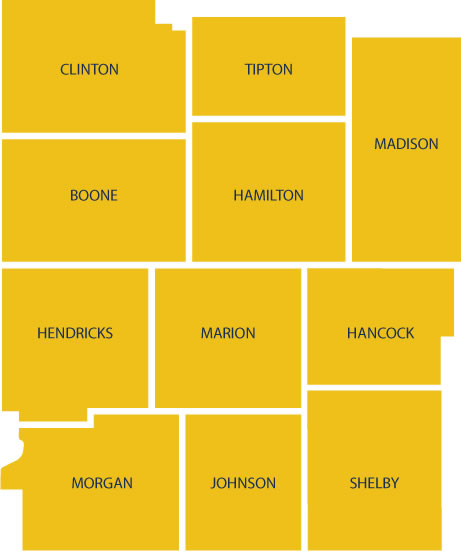Affordable housing helps working families with low incomes
By Victoria Davis
 WITH THE GENTLE SWAY OF HER HAND, Ronda Weybright leads the tour around the offices of RealAmerica Development and Management in Fishers.
WITH THE GENTLE SWAY OF HER HAND, Ronda Weybright leads the tour around the offices of RealAmerica Development and Management in Fishers.
She pauses briefly to reflect on her latest project in Shelbyville where once stood an abandoned 1880s school plastered in graffiti. Set with restored terrazzo floors and high ceilings, photos of the property are revealed as décor within the office.
Dressed in a soft blue shirt and khaki pants, one would never understand these are items Weybright had not always possessed. She grew up in a family that did not thrive financially nor did they have much to call their own.
“My family and I lived in church housing, and in exchange, by dad would mow the lawn,” she said.
Today Weybright is the founder and president of RealAmerica Development and ignites the fire inside herself to help others through the growth in affordable housing.
RealAmerica is one of several companies and organizations responsible for bringing affordable housing to Central Indiana, which includes Marion, Johnson, Morgan, Hendricks, Boone, Clinton, Tipton, Hamilton, Madison, Hancock and Shelby counties.
Founded in 1995, RealAmerica Development LLC, specializes in constructing and managing affordable housing for Indiana residents. With more than 23 properties, in cities like Bargerville, Danville and Shelbyville, 98 percent are dedicated to affordable housing.
“We go to areas when the community contacts us for a need of housing or if we happen to have a connection to someone in the area,” Weybright said. “We have almost 1,600 units in a combination of family and senior housing.”
The process to begin a new development is very competitive, especially in Hamilton and Marion counties, Weybright added.
“A lot of people are developing affordable housing in those counties and the process can be very long.”
HANDS-ON INVOLVEMENT
With an abundance of affordable housing projects taking place, it may be difficult to discover those who are truly passionate about helping the communities in which they work.
“We stay small so I can be apart of every phase,” Weybright said. “When we go to pick out a piece of dirt or site or lay it out, I will be on site. I want to stay involved in every aspect because my name is on the line and reputation. Our investors, Indiana Housing and Community Development Authority, is where we get credit from. My reputation and track record means everything to me.”
Weybright said affordable housing has always been instilled in her simply because of her background. She grew up primarily poor, and after working as a secretary at a real estate company, she knew she had found her passion.
“From that point, I knew I wanted to do real estate, but until I got the opportunity to do farm housing, I knew I had found my passion. I can’t imagine not doing it.”
Over the years, Weybright said, affordable housing has changed physically and includes several amenities to which typical home owners have access. Developers are able to obtain a property based on a point system, called the qualified allocation plan that is administered by the state.
The project is judged on things like location, levels of rent and amenities.
“They’ve encouraged services and amenities, quality, energy-efficiency, all of that for a project to be approved,” Weybright said. “The point system has been really good in notching up the quality. We are now challenged to see what we can bring to the table.”
She refers to all of her properties as “her babies” because they each have a story behind them, and she cares for them as such. Sitting just across her desk is a large lion’s head statue she saved from the school building in Shelbyville.
There wasn’t always a rush to begin construction for affordable housing, Weybright said.
“Our first property we had to get through a few fights for something we thought was important. We wanted to change the stigma and find the growth patterns of the city. After a while, community members were more comfortable and actually recommending places to us. We want people to know they drive pass affordable housing everyday and don’t know it, and that’s the idea.”
All RealAmerica properties, regardless of income level, are furnished with Energy Star-rated appliances, washer and dryers, covered front porches and playgrounds.
QUALITY OF LIFE
Amy Nelson, executive director of the Fair Housing Center of Central Indiana, said not only is affordable housing needed, the location of that housing is specifically important.
“Where someone lives impacts the quality of their lives,” she said. “Having a safe place you call home impacts whether or not your housing investment will flourish, the opportunities you will have, and employment that will be available. Where you live determines if your local supermarket will carry fresh fruits and vegetables, the quality of the schools your children will attend, and your access to businesses and transportation options. Your home is more than a roof over your head.”
Within the state, there are two commonly used housing programs, Section 42 and the section 8 Voucher Program. Section 42 is an affordable rental-housing program implemented by the federal government. The Section 8 Voucher Program is also a government program that allows low-income residents to pay 30 percent of their income to live in safe housing.
Section 42 allows developers of affordable housing to receive a federal tax credit. In exchange the developer will manage the upkeep of the property to maintain safety among other things. Developers agree to keep the housing income restricted as well as the rent. Eligibility for this program is based on household income set by each county and can vary per area.
For example, Hendricks and Johnson counties’ median income limit is set at $64,300 and is then broken down into separate categories based on the number of people living in that household.
Nelson said housing assistance recipients are usually single mothers, those with disabilities and people of color.
“According to Census and HUD (Housing and Urban Development) data, there were 159,157 rental units in Marion County in 2013,” said Nelson. “In contrast there were 7,247 housing choice voucher households in Marion County. Voucher holders were 89 percent Black, 8 percent white, 1 percent Hispanic and 1 percent other.”
Of those using Section 8 in Marion County, 30 percent receive employment wages, but the income is too low to support a family unit she added.
Marty Vangas, vice president of the Indianapolis Chamber of Commerce, said counties scattered across Central Indiana are seeing an increase in affordable housing, and many cities are reconstructing their downtowns to include to residential life.
“Residential development is happening all over the area,” he said.











